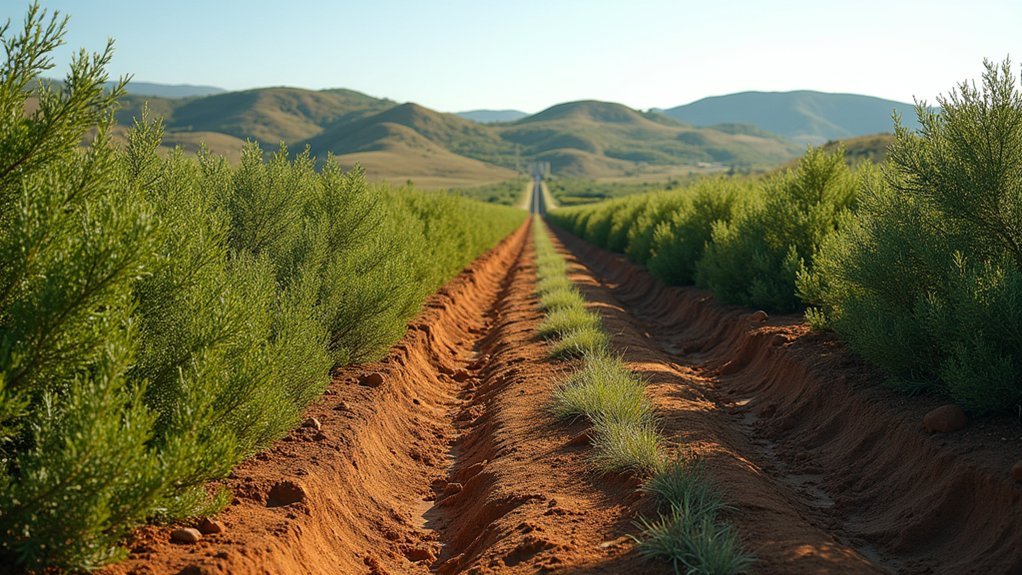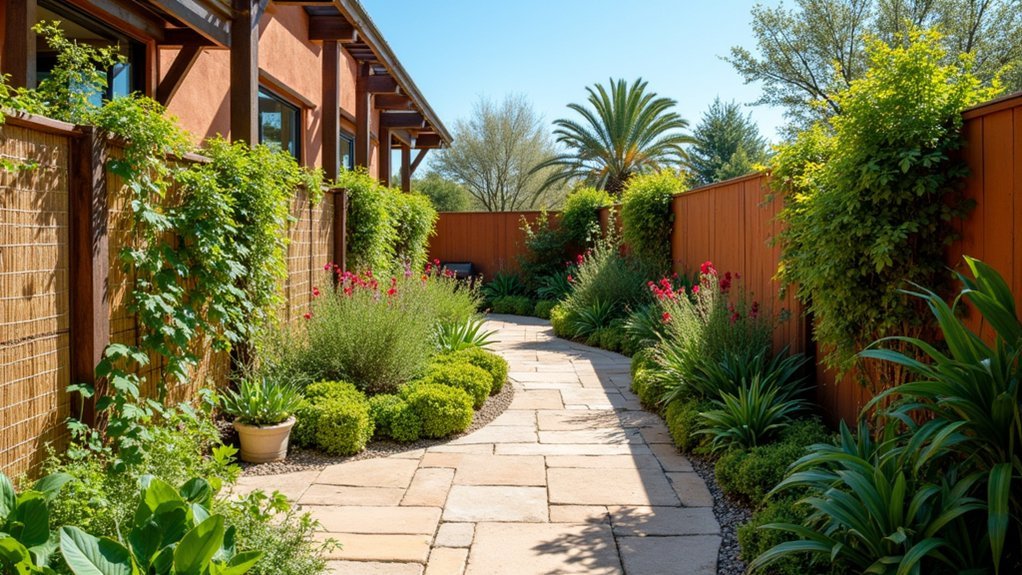Effective windbreaks for erosion protection should maintain 40-60% porosity with multiple rows of mixed trees and shrubs. You’ll need to space plants appropriately—tall trees 3-6 meters apart, medium trees 2-4 meters, and shrubs 1-2 meters. Design your windbreak to be at least 10 times taller than what you’re protecting, creating shelter for up to 30 times its height downwind. Regular maintenance through pruning and monitoring guarantees your living barrier remains ideally functional for years to come.
The Science Behind Windbreak Effectiveness

When designing effective windbreaks, understanding the scientific principles that govern their performance is vital. The key factor in any windbreak design is porosity—the ideal range falls between 0.20 and 0.35, providing the maximum erosion protection while minimizing turbulence.
Effective windbreak design hinges on optimal porosity between 0.20-0.35 to maximize protection while reducing turbulent airflow.
Height directly determines your protected area, as windbreaks can reduce wind speed up to 30 times their height downwind. You’ll achieve superior results with multiple-row windbreaks compared to single rows, especially when using a combination of trees and shrubs tailored to your local conditions.
For maximum effectiveness, design your windbreak with lower porosity at the top and higher porosity at the base.
Remember that protection diminishes considerably beyond 10 times the barrier height, so strategic placement is vital for thorough erosion control across your entire property.
Key Design Principles for Maximum Wind Reduction
To maximize your windbreak’s effectiveness, aim for a porosity level between 0.20-0.35 and maintain density at 60-80% throughout the barrier.
You’ll achieve superior protection by implementing multi-row designs with taller species on the leeward side, creating a structure that extends protection up to 30 times its height downwind.
For thorough coverage of your land, space windbreaks every 10-20 times their height and guarantee each barrier’s length measures at least 10 times its maximum height to minimize end turbulence.
Height and Density Ratios
Designing effective windbreaks requires careful consideration of height and density proportions to maximize wind reduction benefits.
For ideal soil conservation, you’ll need windbreaks at least 10 times taller than your protected trees, as their shelter extends up to 30 times their height downwind.
Maintain a 1:10 height-to-length ratio—a 2-meter windbreak should stretch at least 20 meters to prevent end turbulence. Aim for 60-80% density with proper tree spacing to considerably reduce wind velocity while avoiding complete blockage.
For effective erosion protection, keep porosity between 0.40-0.60, balancing airflow reduction with minimal turbulence.
When planting multi-row windbreaks, position taller species in the center or windward row and space rows 2-4 meters apart to create ideal density while ensuring healthy growth.
Multi-Row Planting Strategies
Although single-row barriers provide basic protection, multi-row windbreaks consisting of two to three rows of trees and shrubs deliver superior shelter for agricultural settings. When implementing multi-row planting strategies, position the tallest trees in the center or windward row with shorter species on the outer rows to maximize wind reduction and minimize turbulence.
| Design Element | Recommendation | Benefit |
|---|---|---|
| Row Spacing | 2-4 meters | Equipment access |
| Height:Length Ratio | 1:10 | Reduces end turbulence |
| Windbreak Density | 0.20-0.35 porosity | Extends area protected |
| Species Selection | Mixed trees/shrubs | Varied heights for efficiency |
| Row Configuration | Tallest row central | Optimizes wind deflection |
Maintain 2-4 meter spacing between rows for growth and maintenance access. Your windbreak should follow the 1:10 height-to-length ratio to properly shelter fields and prevent Soil Erosion around the ends.
Porosity Optimization Techniques
Porosity—the ratio of open space to solid material—stands as the cornerstone of effective windbreak design. For maximum wind-velocity reduction, aim for 20-35% porosity, which creates the ideal balance between penetration and turbulence.
You’ll achieve the longest protected area with evenly distributed porosity across your windbreak structure, maintaining over 50% wind reduction.
When designing multi-row windbreaks, consider that porosity and number of rows work together to enhance effectiveness, particularly within a distance of 10 times the barrier height. Your design depends on the protection target—crops benefit from 40-60% porosity, while structures and livestock protection works best with porosity exceeding 60%.
For advanced wind erosion control, implement a graduated approach: slightly higher porosity at the top than at the base to minimize turbulence while maximizing the protected area.
Optimal Tree and Shrub Species Selection
Selecting the right combination of trees and shrubs forms the foundation of an effective windbreak design.
A carefully selected mix of trees and shrubs creates the backbone of any successful windbreak system.
You’ll want to create a layered effect by planting taller tree species in the windward row with smaller shrubs along the outer edges. For ideal spacing, position tall trees 3-6 meters apart, medium trees and larger shrubs 2-4 meters apart, and smaller shrubs at 1-2 meter intervals.
When designing planted windbreaks, remember that windbreak height determines protection area—typically 20 times the height of your tallest trees.
Consider versatile species like Callistemon viminalis and Elaeagnus umbellata for smaller options, or Persea americana and Inga edulis for taller, edible alternatives.
Maintain a height-to-length ratio of 1:10 to guarantee your windbreak effectively reduces turbulence and controls erosion.
Structural Layouts for Different Terrain Types

Now that we’ve covered species selection, let’s examine how terrain shapes your windbreak design strategy.
In hilly areas, position your tallest trees on the windward side with multiple rows to maximize protection.
For flat landscapes, plant single-row windbreaks perpendicular to prevailing winds, spaced every 10H-20H with a 1:10 height-to-length ratio.
Sandy soil requires windbreaks with 40-60% porosity to reduce erosion while maintaining airflow.
Your protected area will benefit from these strategic layouts:
- Urban settings: Use shorter, dense shrubs to control wind around buildings while reducing turbulence
- Agricultural lands: Implement 2-3 rows of varied heights to boost crop yields by 10-44%
- Sandy regions: Design moderately porous windbreaks that allow some air movement while preventing soil displacement
Maintenance Strategies for Long-Term Protection
While establishing a properly designed windbreak is crucial, its long-term effectiveness hinges on consistent maintenance practices.
You’ll need to implement regular maintenance through pruning and thinning to maintain ideal density (60-80%), preventing excessive turbulence while maximizing wind reduction.
Monitor for pests and diseases vigilantly, as healthy trees provide superior protection against wind erosion.
When you notice weakened or dead trees, prompt replanting guarantees your windbreak maintains its protective capabilities.
Don’t overlook soil health around your windbreaks—mulching and proper irrigation greatly enhance tree resilience and longevity.
Additionally, conduct periodic porosity assessment to evaluate your windbreak’s structural integrity and effectiveness.
These assessments will help you determine if adjustments are needed to accommodate changing landscape conditions or agricultural practices, guaranteeing your windbreak continues providing ideal protection.
Measuring Success: Evaluating Windbreak Performance

To determine if your windbreak is delivering its intended benefits, you’ll need to track wind velocity reduction percentages within the 10-30H leeward zone, where properly designed barriers should achieve over 50% reduction.
You can measure success through crop yield improvements, which can increase by up to 44% with ideal porosity distribution between 40-60%.
Regular performance evaluations should examine both immediate protection metrics and long-term effectiveness indicators such as soil retention, microclimate modifications, and the structural integrity of the windbreak itself.
Quantifiable Protection Metrics
Measuring the success of a windbreak depends on clearly defined protection metrics that allow farmers and land managers to evaluate performance objectively.
Your windbreak’s height directly correlates with its protection zone, reducing wind speeds up to 30 times its height downwind. Ideal porosity between 0.20-0.35 maximizes wind reduction, while maintaining 60-80% density prevents harmful turbulence.
Multi-row windbreaks consistently outperform single-row designs, especially within 10 times the barrier height.
When evaluating your windbreak’s effectiveness, consider:
- Yield improvements up to 44% in sheltered crops
- Wind speed reduction percentages at various distances from the barrier
- Visible soil retention compared to unprotected areas
These measurable metrics help you fine-tune your windbreak design, combining the right mix of trees and shrubs to achieve maximum protection.
Long-term Effectiveness Assessment
Beyond initial installation metrics, a windbreak’s true value emerges through systematic long-term performance evaluation.
You’ll need to measure wind velocity reduction across the total area protected, as effective designs can achieve over 50% reduction in protected zones.
The effect of porosity is critical—optimal porosity between 0.20 and 0.35 correlates with maximum shelter and erosion reduction.
A continuous row of trees provides some protection, but multi-row windbreaks deliver superior long-term benefits, particularly within 10 times the height of the barrier.
When a windbreak is generally about 30 feet tall, it can protect areas up to 600 feet downwind.
Regular monitoring will help you identify maintenance needs, as deterioration considerably compromises effectiveness.
Success metrics should include both wind reduction measurements and soil erosion rates to fully assess your windbreak’s performance over time.
Frequently Asked Questions
What Is the Most Effective Windbreak?
You’ll get the most effective windbreak with 20-35% porosity, using 2-3 rows of trees at 60-80% density. Position them perpendicular to prevailing winds and space them 10-20 times their height apart.
What Is the Most Important Factor in Determining a Windbreaks Downwind Area of Protection?
The height of your windbreak is the most important factor for downwind protection. You’ll get effective wind reduction up to 30 times the height of your tallest trees, maximizing your sheltered area.
How Do Windbreaks Prevent Erosion?
Windbreaks prevent erosion by reducing wind speed across your land. They’ll create a protected zone extending 10-20 times their height, trap soil particles, decrease wind’s erosive force, and improve moisture retention in your soil.
What Is a Wind Barrier to Prevent Wind Erosion?
A wind barrier is a structure you’ll install to block or filter wind flow. It’ll create sheltered zones by reducing wind velocity, preventing soil particles from being picked up and carried away by strong winds.
In Summary
You’ve learned that effective windbreaks require scientific planning, proper design principles, and careful species selection. By tailoring your windbreak layout to your specific terrain and implementing regular maintenance, you’ll maximize erosion protection. Don’t forget to evaluate your windbreak’s performance regularly—this guarantees you’re getting peak results. With these strategies, you’ll create barriers that not only reduce wind velocity but also protect your valuable soil for years to come.





Leave a Reply